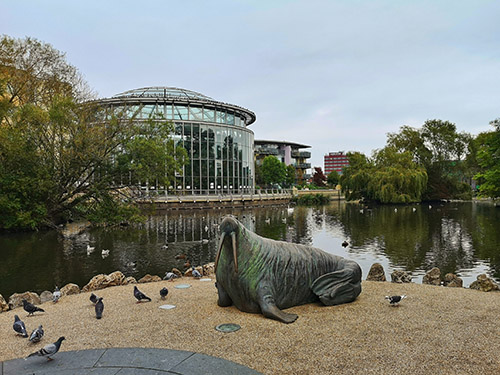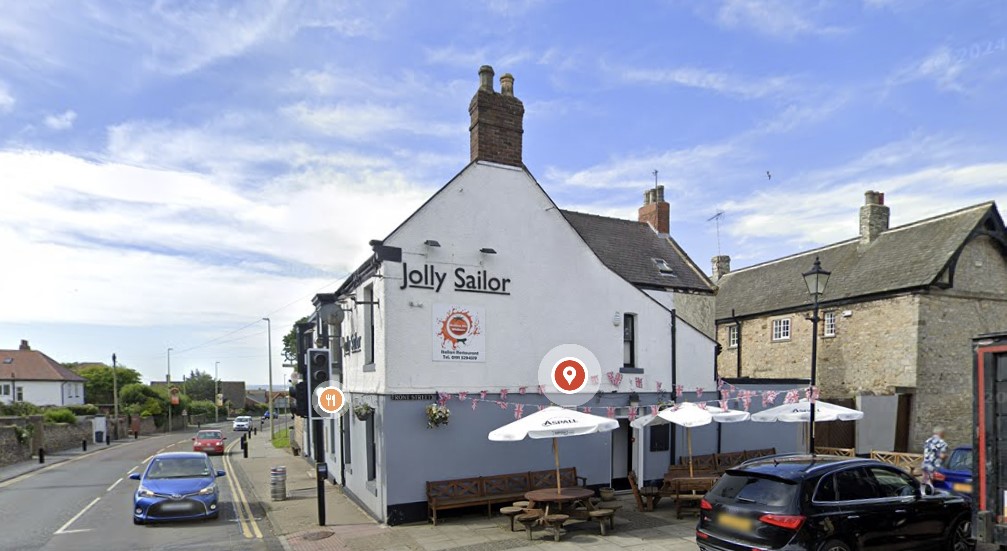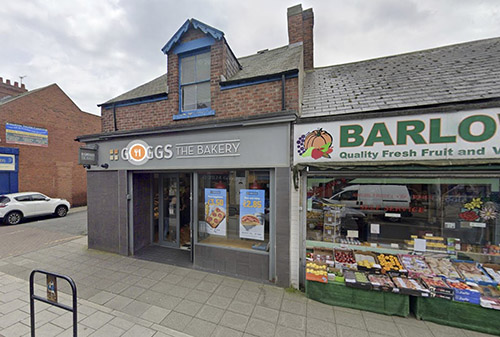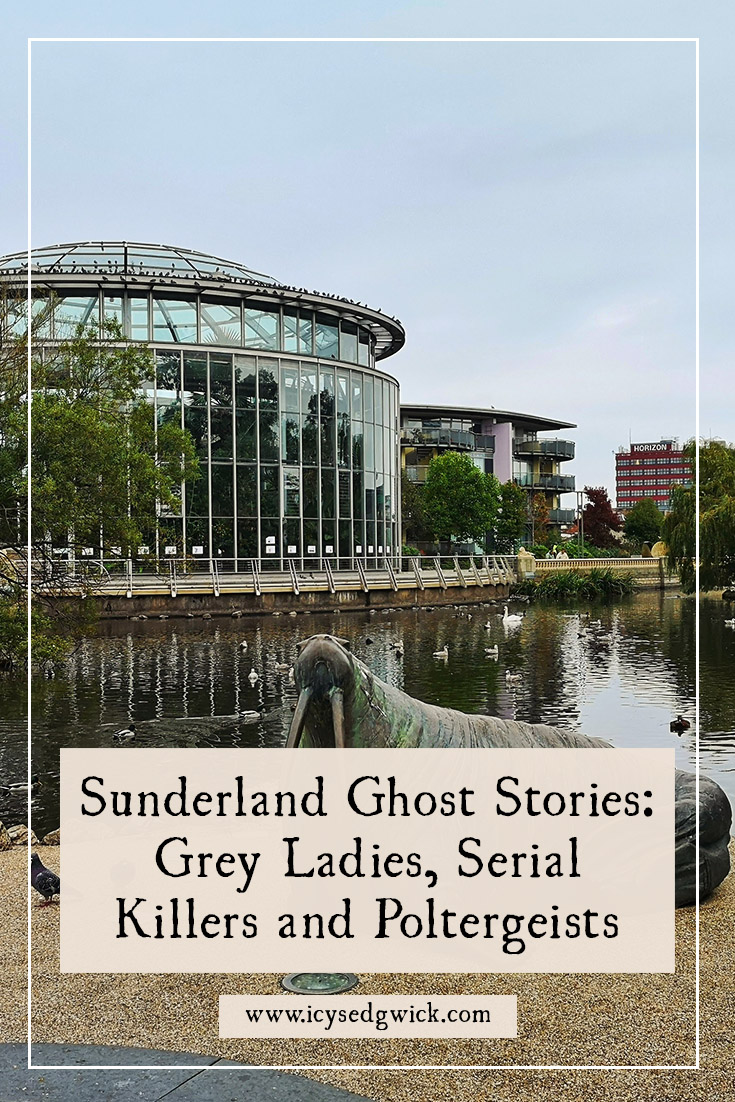Sunderland began life as three separate settlements on the River Wear. While there is evidence of activity in the area long before, these settlements date to 674. King Ecgfrith of Northumbria granted land to Benedict Biscop, who founded Monkwearmouth Monastery in the area. Later, the Bishop of Durham gained these lands and they became Bishopwearmouth. A fishing village called ‘Soender-land’, or land that is cut asunder’ existed by 1100. By the 18th century, Sunderland had replaced Wearmouth, and that’s why we still call it Sunderland now (MySunderland 2024).
In the past, Sunderland has exported coal, lime, alum, ropes, glass, and pottery. Sunderland was the home of Pyrex and it was a major shipbuilding centre. What kind of folklore does this industrial centre have? Let’s hear some Sunderland ghost stories…
Famous Rivalry
Sunderland and Newcastle are famous rivals, but the reason actually has little to do with football. Charles I backed Newcastle for the coal trade, rather than Sunderland. During the Civil War, Sunderland retaliated by backing the Parliamentarians, while Newcastle supported the Royalist cause. At the ensuing Battle of Boldon Hill, Sunderland won with the help of the Scots. During the brief Commonwealth period, the Parliamentarians repaid Sunderland for their loyalty by backing the city over Newcastle (Gardiner 2019: 5).
I would argue that Sunderland and Newcastle have more in common with each other than either city has with London. Both are industrial cities with long histories forced to find new identities with the loss of traditional manufacturing and mining jobs.
Where Newcastle’s inhabitants are called Geordies, Sunderland’s people are called ‘Mackems’. There are two theories as to where the name came from. It referred either to the Blue Macs, or the Scottish soldier stationed in Sunderland during the Civil War. Or it came from shipbuilders whose phrase ‘Mak’em and Tak’em’ referred to ships being made in and taken from Sunderland (MySunderland 2024).
The Cauld Lad o’ Hylton
I’ve covered the Cauld Lad o’ Hylton before, but I thought it was only right to include him again. After all, he is such a legendary character among Sunderland ghost stories. In one version of the legend, he was a brownie who lived in Hylton Castle near Sunderland. The servants rarely saw him, but they heard him at night. As is typical with brownies, if they tided the kitchen, he made a mess and hurled everything around the room. If they left it messy, he tidied it for them.
The servants got tired of his antics and they knew the only way to rid themselves of a brownie was to present him with new clothes. They laid out a green hooded cloak beside the kitchen fire and hid so they could see what would happen. At midnight, the Cauld Lad came into the kitchen. Spotting the cloak, he put it on and danced around the kitchen until dawn. At sunrise, he cried out,
‘Here’s a cloak and there’s a hood,
(Henderson 1879: 266)
The Cauld Lad of Hilton will do no more good’.
Then he vanished, never to be seen again.
In the neighbourhood version of the story, centuries ago a baron had a servant boy. He’d ordered his horse to be ready, but the servant didn’t arrive with the horse at the specified time. The baron went to the stables and found the servant boy asleep. So incensed by the servant’s behaviour, he struck him with a pitchfork, killing him instantly. Suddenly aware of his actions, he covered the boy’s body with straw, and he threw the body into a pond that night. According to the legend, someone discovered a boy’s skeleton in the pond years later, though no details are given as to why they were looking (Henderson 1879: 266).

Surprisingly though, it seems activity continued. In the 19th century, people reported dishes being smashed at the castle. A witness who’d lived nearby in the 1960s as a child claimed to have seen the Cauld Lad in 1969 (Paranormal Database 2024). A mysterious force puts out fires and turns off car lights near the castle (Button 2022).
Haunted Theatres
I’ve featured quite a few haunted theatres now, and Sunderland appears to have not one, but two. The first is the Empire Theatre, which first opened in 1907. A White Lady apparently haunts the theatre, believed to be the ghost of Molly Moselle, a dancer who went missing in 1949. She’d been working as an assistant stage manager at the theatre and disappeared after going out to buy a birthday card. While Molly was never found, human remains turned up in the River Wear in October 1960. Some suggested it was Molly, but it’s never been proven conclusively.

But for some reason, she’s believed to haunt the men’s toilets in the dress circle. A little boy claimed to have talked to her in the toilets during a performance in 2016. The fact he came from London, had never visited Sunderland, and likely hadn’t heard the story meant people paid attention (Ian 2019).
Meanwhile, a Grey Lady haunts the gallery. Staff don’t seem particularly perturbed by her, with one member saying she likes to watch the shows from there, and she’s making sure the performance runs smoothly. Audience members have reported seeing a grey figure behind them in the gallery, although staff won’t rule out these shadowy figures just being ushers (Ian 2019). I don’t know about you, but I like the idea of a Grey Lady performing quality control from the gallery!
A Famous Ghost
Finally, some claim Sid James haunts the theatre after he had a heart attack there in 1976. He died on the way to hospital. Comedian Les Dawson apparently wouldn’t work there after seeing James’ ghost (Button 2022). Others have reported hearing James’ distinctive laugh in his old dressing room and performers hate being assigned his dressing room (Ian 2019). It’s one of the more famous Sunderland ghost stories but people do dispute whether or not actors refused to work there following James’ death
The other venue is the Royalty Theatre off Chester Road. A church originally stood on the site, and the building acted as a hospital in the Second World War. People report shouting, disembodied footsteps, and slamming doors in the theatre. Other visitors report seeing a man sitting at the back of the auditorium (Button 2022).
Pub Folklore
This next instalment of Sunderland ghost stories combines two of my favourite things—secret tunnels, and grey lady ghosts. Even better, there is a green lady and a pink lady on-site too at the Jolly Sailor Inn in Whitburn. This is described as an “ancient coaching inn”, in operation for over three centuries (Ollier 2009).
No one knows much about the Grey Lady, though the catering manager spotted a grey figure going into a bedroom. She described the figure as looking like “a pall of smoke” and said she thought it “seemed to be an old lady” (Ollier 2009).
A green lady wanders the corridors there, believed to be a local girl who took a fancy to a visiting coachman. She bought a green dress to impress him, and sadly, it didn’t work. She died after pining for him and now haunts the upstairs area (Ollier 2009).
There are also rumours of a pink lady but no one seems to know much about her. Other investigations turned up a nurse and a soldier, but again, little is known about them.
The secret tunnel apparently connects the inn with the Marsden Grotto, which is just over two miles to the north. Normally, I’d dismiss this story given the plethora of secret passage legends around the British Isles. However, given the fact the Marsden Grotto was carved out of the cliff to start with, the idea of it being the start (or end) of a secret passage seems less far-fetched.
The most far-fetched part of the legend is the distance involved.
A Connection with a Serial Killer
The other pub we’ll look at is the Ship Isis public house on Silksworth Row. I can debunk this one almost immediately but it’s still a local legend, so we’ll look at it anyway. People have reported seeing two ghostly children around the pub, and as the legend runs, their mother, Mary Ann Cotton, murdered them in tunnels beneath the pub. Other customers have reported a Victorian lady in the pub, so there is speculation this is Mary herself.
Right. First things first, Mary Ann Cotton is one of the most notorious female serial killers, at least in north east history. While no one knows exactly how many people she poisoned, many place the figure around 21 (Tikkanen 2022).
She’s notorious because she kept taking out life insurance policies for her partners and children before they died of apparent ‘gastric fever’. The symptoms of this are incredibly similar to those of arsenic poisoning. It seems Cotton used tea as her delivery mechanism, allowing her to keep giving the poison until it built up in the body to a lethal dose. Cotton apparently kept a small teapot specifically for her poisoning, and Beamish Museum holds the teapot believed to be hers. It’s a black Wedgewood teapot, donated in 1972 (Beamish 2016).
Her activities finally came to light because she tried to give up one of her stepchildren to a workhouse. When they refused to take him unaccompanied by her, she’d told a local official that he wouldn’t trouble her for long. The official informed the police after the seven-year-old died, and the autopsy found arsenic in his stomach. This led to the exhumations of other people close to her, and authorities found arsenic in their stomachs too (Tikkanen 2022).
How does this link with the Ship Isis?
Cotton was hanged in 1873 for her crimes. Now, she had worked in Sunderland, so she does have links with the city, but the Ship Isis opened in 1885. She clearly couldn’t have visited the pub itself in her lifetime, although some say it stands near the location of one of her homes (Button 2022). I can’t help finding it unlikely that she would haunt the pub, rather than the site of her house. As to murdering her children in the tunnels, Cotton administered arsenic at home, and passed off their deaths as gastric fever.
Jason Button repeats a legend that she burned the bodies of two children, which is unlikely since she would need their bodies in order to claim the life insurance…but raises the chilling possibility of another female murderer in the area (2022). Given people report disembodied screams and singing on the site, I’m leaning towards the latter explanation.
The Bishopwearmouth Poltergeist
It also surprised me to discover the story of a poltergeist in Bishopwearmouth. It sounds very similar to the likes of Enfield and Battersea, yet there’s one major difference.
Rather than happening in the 20th century like the poltergeist cases we’re familiar with, this story dates to 1839.
Mary Jobson lived in Bishopwearmouth, then a village but now part of Sunderland. At 13, she fell ill. While that was relatively commonplace in the early 19th century, what happened next was not. Other residents heard inexplicable bangs and footsteps around the house. Bells rang, even when no one was there to ring them. Doctors found Mary’s medicine snatched out of their hands (Paranormal Database 2024).
Even more bizarrely, six months after it all started, an astronomical painting appeared on Mary’s ceiling. If anyone painted whitewash over it, it reappeared – very Canterville Ghost (which, incidentally, didn’t appear until 1887).
Arthur Morrison actually didn’t consider it a poltergeist case, per se, but rather lumps it into his “possession” category. Banish all thoughts of demons from your mind; he defines it as “cases in which a departed spirit enters or seems to enter, the body of a person still living, using it in its own way, speaking with its mouth, hearing with its ears, and so forth” (1891). He does note that many cases are probably more likely a mental health issue, but there are some cases that defy explanation. For him, Jobson fell into this latter category.
One of the doctors, R. B. Embleton, described her early symptoms thus:
“On my first visit, she complained of severe pain on the back part of the head, increased on pressure; her eyes were very sensible to the light, and slightly injected with blood; she had a sensation of sickness, but no vomiting: the heat of the skin was a little above the natural temperature; her bowels were constipated, and her pulse about 120, but very weak, and frequently irregular”.
(Clanny 1841: 2)
Unsurprisingly, leeches did nothing to help. Especially since some of those symptoms sound more like a migraine. She seems to have gone through the wringer, both with her symptoms and the subsequent treatment. She started hearing voices, made predictions that were occasionally accurate, and water appeared from nowhere in the room.
After eight months, she was cured and apparently lived a fairly mundane life. It’s a pity there isn’t more about the case, as to whether it was all activity on Jobson’s part or something in the house. But I thought it was worth including since it’s such an early example of such phenomena. It’s also a major example of these Sunderland ghost stories to have an entire book written about it.
Other Sunderland Ghost Stories
The Paranormal Database includes a range of other interesting Sunderland ghost stories.
In early 1957, people living at a house on General Havelock Road reported being prodded or feeling icy cold water poured over them. Footsteps rang out on the staircase, doors opened and closed on their own, and a weird zig-zag line appeared and disappeared on the living room wall. According to the story, the Bishop of Jarrow blessed the house, and while the haunting seemed to end, it eventually restarted. Unsurprisingly, the family moved (Paranormal Database 2024).
A doctor apparently haunted the now-defunct Ward F62 at the Royal Infirmary Hospital, dedicated to palliative care. He was famous for the scent of his pungent cigars, and staff continued to smell them in the ward before a medical crisis. It became so common that staff checked every patient if they smelled the cigars (Paranormal Database 2024).

Before the Second World War, children avoided an open area called The Swallow, which lay at the end of Westheath Avenue. Stories abounded of a phantom man, described as a ghoul, haunting the land (Paranormal Database 2024).
The North East Aircraft Museum also claims to be haunted, although having done an overnight investigation there back in the early 2010s, I’m unconvinced.
Pasties and Poltergeists
And I absolutely could not resist including this legend, even though it’s so recent, purely because when else am I going to get to include Greggs in a Fabulous Folklore article? This story involved the branch of Greggs on Sea Road in the Fulwell district in 2004. I found it on Google Street View, and it’s typical of buildings you’d find in the area, in a street of single-storey shops. The branch of Greggs has space for a small flat upstairs – which becomes important to the story later on.
According to Paranormal Database, staff experienced a range of activity, including banging sounds coming from the staff room, or electrical items turning on by themselves. They even smelled lavender, and people blamed the ghost of an elderly woman who had lived upstairs (2024).
Staff also heard noises upstairs as if someone was moving furniture, although the flat was empty at the time. The noises were at their worst early in the morning. Paranormal investigator Mike Hallowell suspected a poltergeist at work, though staff also insisted the spirit to be “friendly” (Robertson 2019). Since the activity seems to be restricted to items seemingly operating on their own, banging sounds and a phantom scent, I’d be hesitant to categorise that as a poltergeist. After all, the goal didn’t seem to be to intimidate staff, and there are no reports of anything being thrown, damaged, or going missing – all things I’d expect with a poltergeist.
The activity seems to have ended as soon as it began, so who knows what was behind it all?
What do we make of these Sunderland ghost stories?
Obviously most of these stories have involved ghosts. Sunderland’s got a lot of other things in its history too, but these are the ones that stood out as being interesting to relate with a focus on folklore, rather than local history.
I think the fact that there’s a relatively high number of recent stories brings us into the actual psychic activity of the city as it is now, rather than just focusing on the stories of past centuries. It reminds us that cities are a concentration of people in a place through time. So you’ve almost got three coordinates to deal with.
It would be really weird if there weren’t ghost stories attached to cities. In a lot of ways, they remind us that we’re not the first ones here and we probably won’t be the last ones here.
Do you know any other Sunderland ghost stories?
References
Beamish Museum (2016), ‘Mary Ann Cotton’s Teapot at Beamish!’, Beamish Museum, https://www.beamish.org.uk/news/mary-ann-cottons-teapot-at-beamish/.
Button, Jason (2022), ‘The most haunted places in Sunderland: From Hylton Castle to the Empire Theatre’, Sunderland Echo, https://www.sunderlandecho.com/whats-on/things-to-do/the-most-haunted-places-in-sunderland-from-hylton-castle-to-the-empire-theatre-3880930.
Clanny, William Reid (1841), A Faithful Record of the Miraculous Case of Mary Jobson, second edition, Newcastle upon Tyne: M. A. Richardson.
Gardiner, Marie (2019), Secret Sunderland, Stroud: Amberley.
Henderson, William (1879), Notes on the folk-lore of the northern counties of England and the borders, London: W. Satchell, Peyton and Co.
Ian (2019), ‘The Empire Theatre, Sunderland’, Mysterious Britain, https://www.mysteriousbritain.co.uk/hauntings/the-empire-theatre-sunderland/.
Morrison, Arthur (1891), The Shadows Around Us: Authentic Tales of the Supernatural, London: Simpkin & Marshall.
Ollier, Mike (2009), ‘Haunted pub’s ‘resident ghosts”, BBC Wear, https://web.archive.org/web/20091029162056/http://news.bbc.co.uk/local/wear/hi/people_and_places/history/newsid_8326000/8326061.stm.
MySunderland (2024), ‘History of Sunderland, MySunderland, https://www.mysunderland.co.uk/article/18607/History-of-Sunderland.
Paranormal Database (2024), ‘Tyne and Wear Ghosts, Folklore and Forteana’, Paranormal Database, https://www.paranormaldatabase.com/tyneandwear/index.php?pageNum_paradata=2&totalRows_paradata=77.
Tikkanen, Amy (2022), ‘Mary Ann Cotton’, Encyclopedia Britannica, https://www.britannica.com/biography/Mary-Ann-Cotton.
Nutty about folklore and want more?
Add your email below and get these posts in your inbox every week.
You'll also get my 5-step guide to protecting your home using folklore!











Have your say!